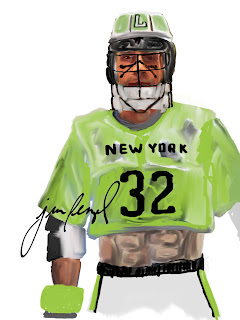 |
| Casey Powell |
I grew up when the game was played with bucket helmets and arm pads you either strapped on, or the pull-on type that would undoubtedly get loose, and you'd have to tape them. Wear them one summer practice, they'd still be wet with sweat for the next. My gloves (usually Brine L35) had the palms cut out, and I'd sneak a couple fingers out every now and then for a better grip on the stick. My sticks were STX--SAMs and Excaliburs and Laser Hi-walls. I didn't like the little nubs on the Brine SLIIs and Superlight 4s that your sidewall would string through--they'd crack off from the rest of the head (when hit with the ball or a check), and you'd have to tape the sidewall string to the head. In high school, I wore the double chin pad, because, well, coolness.
Most of my sticks were traditionally strung. Jim Ulman (UVA) was my favorite retailer. He strung his traditional pocket with nylons in place of the leathers and used hard plastic sleeves to protect them at the of the head where they'd scrape the ground on groundballs. I usually used a wooden pole.
I was in high school when the titanium shaft first came out. In college everyone transitioned from the bucket to the first iteration of the non-paneled helmets you see today. (Actually, in ten grade we used the Riddell--basically a batting helmet with a facemask--awful. My coach knew times were about to change, he just jumped the gun, backed the wrong horse. We sent them down to the JV team the next season). As a coach, I picked up an offset head and was amazed at how easy it made shooting the ball and keeping the ball. It used to take rare skill to cradle at one's ankles Jeff Long (IC head coach)
Point is, things change, but there's always a loving pull from the past. So I drew some of my favorite current stars of the MLL as they might have looked in 70's/80's/90's.
 |
| Kyle Harrison |
 |
| Greg Beast Gurenlian |
See more illustrations here









